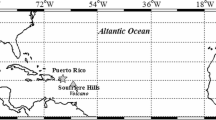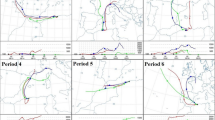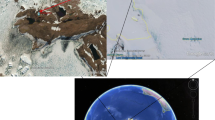Abstract
The concentration and particle-size distribution of ionic species in Antarctic aerosol samples were determined to investigate their potential sources, chemical evolution, and transport. We analyzed aerosol samples collected at two different Antarctic sites: a coastal site near Victoria Land close to the Italian Research Base “Mario Zucchelli”, and another site located on the Antarctic plateau, close to Italian-French Concordia Research Station. We investigated anionic compounds using ion-chromatography coupled to mass spectrometry, and cationic species through capillary ion chromatography with conductometry. Aerosol collected close to the coast was mainly characterized by sea salt species such as Na+, Mg2+, and SO4 2−. These species represented a percentage of 88% of the total sum of all detected ionic species in the aerosol samples from the coastal site. These species were mainly distributed in the coarse fraction, confirming the presence of primary aerosol near the ocean source. Aerosol collected over the Antarctic plateau was characterized by high acidity, with nss-SO4 2−, NO3 −, and methanesulfonic acid as the most abundant species. These species were mainly distributed in the <0.49 μm fraction, and they had a behavior of a typical secondary aerosol, where several chemical and physical processes occurred.




Similar content being viewed by others
Explore related subjects
Discover the latest articles and news from researchers in related subjects, suggested using machine learning.References
Barbaro E, Kirchgeorg T, Zangrando R, Vecchiato M, Piazza R, Barbante C, Garnbaro A (2015a) Sugars in Antarctic aerosol. Atmos Environ 118:135–144
Barbaro E, Zangrando R, Vecchiato M, Piazza R, Cairns WRL, Capodaglio G, Barbante C, Gambaro A (2015b) Free amino acids in Antarctic aerosol: potential markers for the evolution and fate of marine aerosol. Atmos Chem Phys 15:5457–5469
Becagli S, Scarchilli C, Traversi R, Dayan U, Severi M, Frosini D, Vitale V, Mazzola M, Lupi A, Nava S, Udisti R (2012) Study of present-day sources and transport processes affecting oxidised Sulphur compounds in atmospheric aerosols at dome C (Antarctica) from year-round sampling campaigns. Atmos Environ 52:98–108
Blackall TD, Wilson LJ, Theobald MR, Milford C, Nemitz E, Bull J, Bacon PJ, Hamer KC, Wanless S, Sutton MA (2007) Ammonia emissions from seabird colonies. Geophys Res Lett 34
Bliesner DM (2006) Validating chromatographic methods a practical guide. John Wiley & Sons, Inc., Hoboken, New Jersey
Cunningham WC, Zoller WH (1981) The chemical composition of remote area aerosols. Journal of Aerosol Sciences 12:367–384
deMora SJ, Wylie DJ, Dick AL (1997) Methanesulphonate and non-sea salt sulphate in aerosol, snow, and ice on the East Antarctic plateau. Antarct Sci 9:46–55
Fattori I, Becagli S, Bellandi S, Castellano E, Innocenti M, Mannini A, Severi M, Vitale V, Udisti R (2005) Chemical composition and physical features of summer aerosol at Terra Nova Bay and dome C, Antarctica. J Environ Monit 7:1265–1274
Fiore AM, Naik V, Leibensperger EM (2015) Air quality and climate connections. J Air Waste Manage Assoc 65:645–685
Fu P, Kawamura K, Usukura K, Miura K (2013) Dicarboxylic acids, ketocarboxylic acids and glyoxal in the marine aerosols collected during a round-the-world cruise. Mar Chem 148:22–32
Hara K et al. (2004) Chemistry of sea-salt particles and inorganic halogen species in Antarctic regions: compositional differences between coastal and inland stations. J Geophys Res Atmos 109(D20). doi:10.1029/2004JD004713
Hillamo R, Allegrini I, Sparapani R, Kerminen V-M (1998) Mass size distributions and precursor gas concentrations of major inorganic ions in’Antarctic aerosol. Int J Environ Anal Chem 71:353–372
IPCC (2007) Synthesis report, contribution of working groups I, II and III to the forth assessment report of the intergovernmental panel on climate change, intergovernmental panel on climate change: climate change 2007. Switzerland, Geneva
Jickells TD, Kelly SD, Baker AR, Biswas K, Dennis PF, Spokes LJ, Witt M, Yeatman SG (2003) Isotopic evidence for a marine ammonia source. Geophys Res Lett 30(7). doi:10.1029/2002GL016728
Johnson MT, Bell TG (2008) Coupling between dimethylsulfide emissions and the ocean-atmosphere exchange of ammonia. Environ Chem 5:259–267
Jourdain B, Legrand M (2001) Seasonal variations of atmospheric dimethylsulfide, dimethylsulfoxide, sulfur dioxide, methanesulfonate, and non-sea-salt sulfate aerosols at Dumont d’Urville (coastal Antarctica) (December 1998 to July 1999). J Geophys Res-Atmos 106:14391–14408
Jourdain B, Legrand M (2002) Year-round records of bulk and size-segregated aerosol composition and HCl and HNO3 levels in the Dumont d’Urville (coastal Antarctica) atmosphere: implications for sea-salt aerosol fractionation in the winter and summer. J Geophys Res Atmos 107(D22). doi:10.1029/2002JD002471
Jourdain B, Preunkert S, Cerri O, Castebrunet H, Udisti R, Legrand M (2008) Year-round record of size-segregated aerosol composition in central Antarctica (Concordia station): implications for the degree of fractionation of sea-salt particles. J Geophys Res Atmos 113(D14). doi:10.1029/2007JD009584
Kawamura K, Ikushima K (1993) Seasonal-Changes in the distribution of dicarboxylic-acids in the Urban atmosphere. Environmental Science & Technology 27:2227–2235
Kawamura K, Kasukabe H, Barrie LA (1996a) Source and reaction pathways of dicarboxylic acids, ketoacids and dicarbonyls in arctic aerosols: one year of observations. Atmos Environ 30:1709–1722
Kawamura K, Semere R, Imai Y, Fujii Y, Hayashi M (1996b) Water soluble dicarboxylic acids and related compounds in Antarctic aerosols. J Geophys Res-Atmos 101:18721–18728
Kawamura K, Sakaguchi F (1999) Molecular distributions of water soluble dicarboxylic acids in marine aerosols over the Pacific Ocean including tropics. J Geophys Res-Atmos 104:3501–3509
Kerminen VM, Teinila K, Hillamo R (2000) Chemistry of sea-salt particles in the summer Antarctic atmosphere. Atmos Environ 34:2817–2825
Legrand M, Fenietsaigne C, Saltzman ES, Germain C (1992) Spatial and Temporal variations of METHANESULFONIC-acid and non-SEASALT sulfate in Antarctic Ice. J Atmos Chem 14:245–260
Legrand M, Ducroz F, Wagenbach D, Mulvaney R, Hall J (1998) Ammonium in coastal Antarctic aerosol and snow: role of polar ocean and penguin emissions. J Geophys Res-Atmos 103:11043–11056
Legrand M, Pasteur EC (1998) Methane sulfonic acid to non-sea-salt sulfate ratio in coastal Antarctic aerosol and surface snow. J Geophys Res-Atmos 103:10991–11006
Legrand M, Gros V, Preunkert S, Sarda-Esteve R, Thierry AM, Pepy G, Jourdain B (2012): A reassessment of the budget of formic and acetic acids in the boundary layer at Dumont d’Urville (coastal Antarctica): The role of penguin emissions on the budget of several oxygenated volatile organic compounds. J Geophys Res Atmos117(6). doi:10.1029/2011JD017102
Legrand M, Yang X, Preunkert S, Theys N (2016) Year-round records of sea salt, gaseous, and particulate inorganic bromine in the atmospheric boundary layer at coastal (Dumont d’Urville) and central (Concordia) East Antarctic sites. J Geophys Res-Atmos 121:997–1023
Legrand MR, Delmas RJ (1986) Relative contributions of tropospheric and stratospheric sources to nitrate in Antarctic snow. Tellus, Ser. B 38
Legrand MR, Kirchner S (1990) Origins and variations of nitrate in South polar precipitation. J Geophys Res-Atmos 95:3493–3507
Matsumoto K, Nagao I, Tanaka H, Miyaji H, Iida T, Ikebe Y (1998) Seasonal characteristics of organic and inorganic species and their size distributions in atmospheric aerosols over the Northwest Pacific Ocean. Atmos Environ 32:1931–1946
Minikin A, Legrand M, Hall J, Wagenbach D, Kleefeld C, Wolff E, Pasteur EC, Ducroz F (1998) Sulfur-containing species (sulfate and methanesulfonate) in coastal Antarctic aerosol and precipitation. J Geophys Res-Atmos 103:10975–10990
Mochida M, Umemoto N, Kawamura K, Lim HJ, Turpin BJ (2007): Bimodal size distributions of various organic acids and fatty acids in the marine atmosphere: Influence of anthropogenic aerosols, Asian dusts, and sea spray off the coast of East Asia. J Geophys Res Atmos 112(15). doi:10.1029/2006JD007773
Morganti A, Becagli S, Castellano E, Severi M, Traversi R, Udisti R (2007) An improved flow analysis-ion chromatography method for determination of cationic and anionic species at trace levels in Antarctic ice cores. Anal Chim Acta 603:190–198
O’Dowd CD, Facchini MC, Cavalli F, Ceburnis D, Mircea M, Decesari S, Fuzzi S, Yoon YJ, Putaud JP (2004) Biogenically driven organic contribution to marine aerosol. Nature 431:676–680
Preunkert S, Jourdain B, Legrand M, Udisti R, Becagli S, Cerri O (2008): Seasonality of sulfur species (dimethyl sulfide, sulfate, and methanesulfonate) in Antarctica: Inland versus coastal regions. J Geophys Res Atmos 113(15). doi:10.1029/2008JD009937
Rankin AM, Wolff EW (2002) Frost flowers: implications for tropospheric chemistry and ice core interpretation. J Geophys Res Atmos 107(23). doi:10.1029/2002JD002492
Rankin AM, Wolff EW (2003) A year-long record of size-segregated aerosol composition at Halley, Antarctica. J Geophys Res Atmos 108(24). doi:10.1029/2003JD003993
Saiz-Lopez A, Mahajan AS, Salmon RA, Bauguitte SJ, Jones AE, Roscoe HK, Plane JM (2007) Boundary layer halogens in coastal Antarctica. Science 317:348–351
Sander R, Keene WC, Pszenny AAP, Arimoto R, Ayers GP, Baboukas E, Cainey JM, Crutzen PJ, Duce RA, Honninger G, Huebert BJ, Maenhaut W, Mihalopoulos N, Turekian VC, Van Dingenen R (2003) Inorganic bromine in the marine boundary layer: a critical review. Atmos Chem Phys 3:1301–1336
Schmale J, Schneider J, Nemitz E, Tang YS, Dragosits U, Blackall TD, Trathan PN, Phillips GJ, Sutton M, Braban CF (2013) Sub-Antarctic marine aerosol: dominant contributions from biogenic sources. Atmos Chem Phys 13:8669–8694
Smith W, Kalber A (1974): Handbook of marine science. vol. 2.
Spolaor A, Vallelonga P, Plane JMC, Kehrwald N, Gabrieli J, Varin C, Turetta C, Cozzi G, Kumar R, Boutron C, Barbante C (2013) Halogen species record Antarctic Sea ice extent over glacial-interglacial periods. Atmos Chem Phys 13:6623–6635
Spolaor A, Vallelonga P, Gabrieli J, Martma T, Bjorkman MP, Isaksson E, Cozzi G, Turetta C, Kjaer HA, Curran MAJ, Moy AD, Schoenhardt A, Blechschmidt AM, Burrows JP, Plane JMC, Barbante C (2014) Seasonality of halogen deposition in polar snow and ice. Atmos Chem Phys 14:9613–9622
Teinila K, Kerminen VM, Hillamo R (2000) A study of size-segregated aerosol chemistry in the Antarctic atmosphere. J Geophys Res-Atmos 105:3893–3904
Traversi R, Becagli S, Castellano E, Cerri O, Morganti A, Severi M, Udisti R (2009) Study of dome C site (east Antartica) variability by comparing chemical stratigraphies. Microchem J 92:7–14
Udisti R, Dayan U, Becagli S, Busetto M, Frosini D, Legrand M, Lucarelli F, Preunkert S, Severi M, Traversi R, Vitale V (2012) Sea spray aerosol in Central Antarctica. Present atmospheric behaviour and implications for paleoclimatic reconstructions. Atmos Environ 52:109–120
Wang HB, Kawamura K, Yamazaki K (2006) Water-soluble dicarboxylic acids, ketoacids and dicarbonyls in the atmospheric aerosols over the Southern Ocean and western Pacific Ocean. J Atmos Chem 53:43–61
Weller R, Woeltjen J, Piel C, Resenberg R, Wagenbach D, Koenig-Langlo G, Kriews M (2008) Seasonal variability of crustal and marine trace elements in the aerosol at Neumayer station, Antarctica. Tellus Series B-Chemical and Physical Meteorology 60:742–752
Wolfenbarger JK, Seinfeld JH (1990) Inversion of aerosol size distribution data. J Aerosol Sci 21:227–247
Wolff EW, Rankin AM, Rothlisberger R (2003) An ice core indicator of Antarctic sea ice production? Geophys Res Lett 30(22). doi:10.1029/2003GL018454
Wyputta U (1997) On the transport of trace elements into Antarctica using measurements at the Georg-von-Neumayer station. Tellus B 49:93–111
Xu G, Gao Y, Lin Q, Li W, Chen L (2013) Characteristics of water-soluble inorganic and organic ions in aerosols over the Southern Ocean and coastal East Antarctica during austral summer. J Geophys Res-Atmos 118:13303–13318
Yao XH, Fang M, Chan CK (2003) The size dependence of chloride depletion in fine and coarse sea-salt particles. Atmos Environ 37:743–751
Zangrando R, Barbaro E, Vecchiato M, Kehrwald NM, Barbante C, Gambaro A (2016) Levoglucosan and phenols in marine, coastal and inland Antarctic aerosols. Science of Total Environment 544:606–616
Zhuang H, Chan CK, Fang M, Wexler AS (1999) Formation of nitrate and non-sea-salt sulfate on coarse particles. Atmos Environ 33:4223–4233
Acknowledgments
This work was financially supported by the Italian National Program of Antarctic Research (PNRA) through the project ‘Studio delle sorgenti e dei processi di trasferimento dell’ aerosol atmosferico antartico’ (no. 2009/A2.11). The research was also supported by the National Research Council of Italy (Consiglio Nazionale delle Ricerche, CNR). The authors thank ELGA LabWater for providing the Pure-Laboratory Option-R and Ultra Analytic, which produced the ultrapure water used in these experiments.
Author information
Authors and Affiliations
Corresponding author
Additional information
Responsible editor: Gerhard Lammel
Rights and permissions
About this article
Cite this article
Barbaro, E., Padoan, S., Kirchgeorg, T. et al. Particle size distribution of inorganic and organic ions in coastal and inland Antarctic aerosol. Environ Sci Pollut Res 24, 2724–2733 (2017). https://doi.org/10.1007/s11356-016-8042-x
Received:
Accepted:
Published:
Issue Date:
DOI: https://doi.org/10.1007/s11356-016-8042-x




